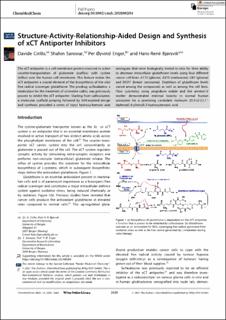| dc.contributor.author | Cirillo, Davide | |
| dc.contributor.author | Sarowar, Shahin | |
| dc.contributor.author | Enger, Per Øyvind | |
| dc.contributor.author | Bjørsvik, Hans-René | |
| dc.date.accessioned | 2021-12-09T08:25:01Z | |
| dc.date.available | 2021-12-09T08:25:01Z | |
| dc.date.created | 2021-04-26T13:57:43Z | |
| dc.date.issued | 2021 | |
| dc.identifier.issn | 1860-7179 | |
| dc.identifier.uri | https://hdl.handle.net/11250/2833499 | |
| dc.description.abstract | The xCT antiporter is a cell membrane protein involved in active counter-transportation of glutamate (outflux) with cystine (influx) over the human cell membrane. This feature makes the xCT antiporter a crucial element of the biosynthesis of the vital free radical scavenger glutathione. The prodrug sulfasalazine, a medication for the treatment of ulcerative colitis, was previously proven to inhibit the xCT antiporter. Starting from sulfasalazine, a molecular scaffold jumping followed by SAR-assisted design and synthesis provided a series of styryl hydroxy-benzoic acid analogues that were biologically tested in vitro for their ability to decrease intracellular glutathione levels using four different cancer cell lines: A172 (glioma), A375 (melanoma), U87 (glioma) and MCF7 (breast carcinoma). Depletion of glutathione levels varied among the compounds as well as among the cell lines. Flow cytometry using propidium iodide and the annexin V marker demonstrated minimal toxicity in normal human astrocytes for a promising candidate molecule (E)-5-(2-([1,1′-biphenyl]-4-yl)vinyl)-2-hydroxybenzoic acid. | en_US |
| dc.language.iso | eng | en_US |
| dc.publisher | Wiley | en_US |
| dc.rights | Attribution-NonCommercial-NoDerivatives 4.0 Internasjonal | * |
| dc.rights.uri | http://creativecommons.org/licenses/by-nc-nd/4.0/deed.no | * |
| dc.title | Structure-Activity-Relationship-Aided Design and Synthesis of xCT Antiporter Inhibitors | en_US |
| dc.type | Journal article | en_US |
| dc.type | Peer reviewed | en_US |
| dc.description.version | publishedVersion | en_US |
| dc.rights.holder | Copyright 2021 The Authors | en_US |
| cristin.ispublished | true | |
| cristin.fulltext | original | |
| cristin.qualitycode | 1 | |
| dc.identifier.doi | 10.1002/cmdc.202100204 | |
| dc.identifier.cristin | 1906443 | |
| dc.source.journal | ChemMedChem | en_US |
| dc.source.pagenumber | 2650-2668 | en_US |
| dc.identifier.citation | ChemMedChem. 2021, 16 (17), 2650-2668. | en_US |
| dc.source.volume | 16 | en_US |
| dc.source.issue | 17 | en_US |

